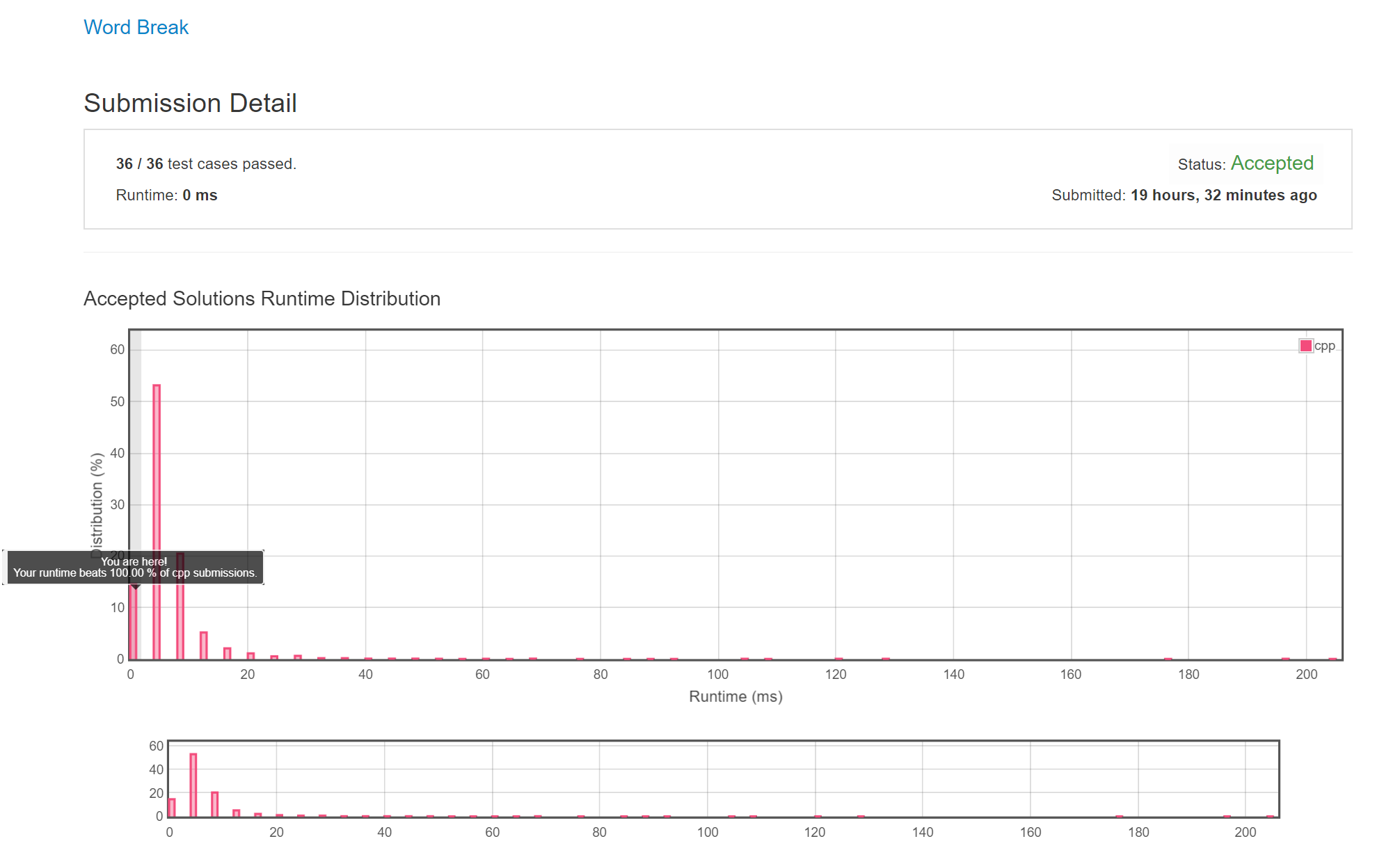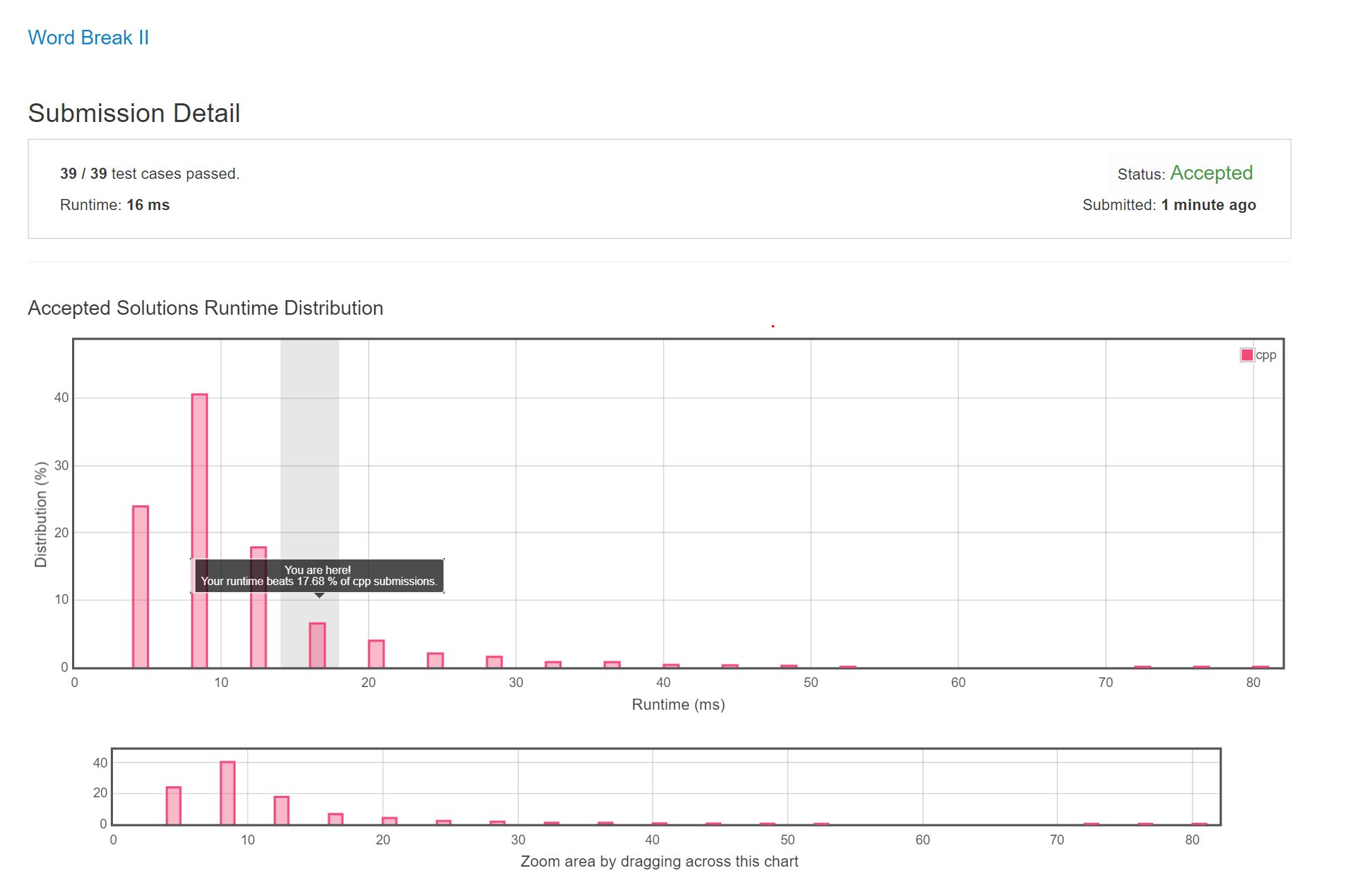Word Break Problems
Word Break
Description
Given a non-empty string s and a dictionary wordDict containing a list of non-empty words, determine if s can be segmented into a space-separated sequence of one or more dictionary words.
Note:
The same word in the dictionary may be reused multiple times in the segmentation.
You may assume the dictionary does not contain duplicate words.
Example
Example One:
Input: s = “leetcode”, wordDict = [“leet”, “code”]
Output: true
Explanation: Return true because “leetcode” can be segmented as “leet code”.Example Two:
Input: s = “applepenapple”, wordDict = [“apple”, “pen”]
Output: true
Explanation: Return true because “applepenapple” can be segmented as “apple pen apple”.
Note that you are allowed to reuse a dictionary word.Example Three:
Input: s = “catsandog”, wordDict = [“cats”, “dog”, “sand”, “and”, “cat”]
Output: false
Analysis
题目意思为,给出一个字符串,和一个包含某些字符串的字典,判断给出字符串能否分割为字典内的字符串序列。如样例一,leetcode 和字典[“leet”, “code”],这是可行的,因为 leetcode 可以分割为 “leet code”。
我们来试试 dp (虽然这个 dp 和普通循环的算法差别不是特别大,希望看看其他大佬的想法)。
设输入字符串为 $str[0…n-1]$,字典为 $dict=[…]$。构造 $dp[0…n]$,其中 $dp[m], m \in [0, n]$ 表示 $str[0…m]$ 能否被分割为合法的字典串序列。
原问题的解答就是 $dp[n]$。对于子问题:$dp[i]$ 的值,我们考量所有串 $str[j, i], j \in [0, i-1]$,当 $dp[j]$ 不合法时,那么无论串 $str[j, i]$ 是否合法,$dp[i]$ 都不合法;当 $dp[j]$ 合法时,那么 $dp[i]$ 合法性取决于串 $str[j, i]$ 的合法性。但是,对于 $dp[i]$ 的最终取值,它是所有 $j$ 决定的 $dp[i]$ 的值的或。可以考虑这个情况:
str = abcd,dict = [“a”, “bcd”],dp[0…4] = {true, true, false, false, unknown}。
当前正在判断 $dp[4]$,当 $j = 3$ 时,计算得 $dp[4] = false$($dp[3] = fasle$),但是,可以看到,继续计算到 $j = 1$ 时,计算得 $dp[4] = true$($dp[1] = true$ 且串 bcd 合法),所以 $dp[4]$ 的值是所有求得的 $dp[4]$ 值的或。
对于 $dp[0]$,我们设为 true,因为空串属于字典是可以定义的。
下面是计算式:
$$dp[i] = \bigvee\limits_{0 <= j < i} (dp[j] \land valid(substr(j, i - j)))$$
根据计算式子,我们写出伪代码:
1 | dp[0...n] = false |
AC Picture

Code
1 | bool wordBreak(string s, vector<string> &dict) { |
Word Break II
Description
Given a non-empty string s and a dictionary wordDict containing a list of non-empty words, add spaces in s to construct a sentence where each word is a valid dictionary word. Return all such possible sentences.
Note:
The same word in the dictionary may be reused multiple times in the segmentation.
You may assume the dictionary does not contain duplicate words.
Example
Example One:
Input:
s = “catsanddog”
wordDict = [“cat”, “cats”, “and”, “sand”, “dog”]
Output:
[
“cats and dog”,
“cat sand dog”
]Example Two:
Input:
s = “pineapplepenapple”
wordDict = [“apple”, “pen”, “applepen”, “pine”, “pineapple”]
Output:
[
“pine apple pen apple”,
“pineapple pen apple”,
“pine applepen apple”
]
Explanation: Note that you are allowed to reuse a dictionary word.Example Three:
Input:
s = “catsandog”
wordDict = [“cats”, “dog”, “sand”, “and”, “cat”]
Output:
[]
Analysis
题目意思为输出给定串可分割的所有合法字典序列。我们可以利用上面的 dp 进行适当的改造,来构造答案:
- 增加一个二维数组,用于存储节点 i 的父节点;
- 当发现一个解时,存储其父节点值,并继续向前求解,而不是跳过;
算法伪代码如下:
1 | dp[0...n] = false |
最终,我们可以得到一个存储了当前有解节点的父节点的二维数组,通过样例二来说明:
输入: str = “pineapplepenapple”, dict = [“apple”, “pen”, “applepen”, “pine”, “pineapple”]
当 i = 4,j = 0,得到 pine,dp[4] = true,graph[4] = [0];
当 i = 9,j = 5,得到 apple,dp[9] = true,graph[9] = [5];
当 i = 9,j = 0,得到 pineapple,dp[9] = true,graph[9] = [5,0];
当 i = 12,j = 9,得到 pen,dp[12] = true,graph[12] = [9];
当 i = 12,j = 4,得到 applepen,dp[12] = true,graph[12] = [9,4];
当 i = 17,j = 12,得到 apple,dp[17] = true,graph[17] = [12];
最终,我们得到:
1 | dp[0...17] = {T,F,F,F,T,F,F,F,F,T,F,F,T,F,F,F,F,T} |
根据 graph,我们利用 dfs 可以重构出所有的解序列。
1 | # dfs current node(int) |
我们根据需要,每次 dfs 返回一个字符串数组,然后处理返回的字符串数组。对于返回的字符串数组,代表其子节点对应的解序列个数,每一个解序列,我们需要加上当前节点的字符串(有解序列则添加一个空格)。最终构造出所有的解序列。
AC Picture

Code
1 | vector<string> wordBreak(string &s, vector<string>& dict) { |
